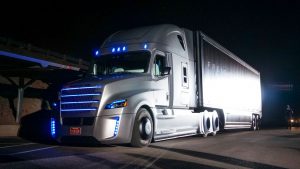
The advent of self-driving vehicles is gearing up to be a major game changer across all transport industries. The freight and supply chain industry, in particular, could see radical changes if the new technology becomes widely implemented. This article reports on the use of self-driving vehicles in road freight transportation and examines how this technology could reduce costs and benefit hauliers in the light of increasing freight transport demand. Additionally, it investigates the impact of this technology on society and other supply chain members, and identifies current implementation barriers and potentials for future developments.
Impact of increased demand in the freight transport market
Both the Irish Central Statistics Office and the European Environment Agency report a considerable growth in the demand for cross-European freight transport. This fact raises concerns over road safety as drivers encounter more complex tasks in the light of increasing traffic intensity. Based on this concern, the World Health Organisation anticipates increased numbers of road accidents and associated fatalities. In 2013 there were 1.25 million road traffic deaths reported on a global scale, and another 20-50 million people involved in non-fatal road accidents. However, these numbers are likely to fall as the adoption of self-driving vehicles is anticipated to eliminate road traffic accidents caused by human error, even though driverless vehicles still need to improve in some key areas.
What are self-driving vehicles?
According to the National Highway Traffic Safety Administration self-driving vehicles can be defined as the vehicles which do not require any “direct driver input, to control the steering, acceleration, and braking” of the vehicle, and do not require the driver to “constantly monitor the roadway while operating in self-driving mode”. That is because, self-driving vehicles are anticipated to adapt to the speed of nearby vehicles and maintain a regular distance from the preceding vehicle. This technology can be conceptualised using a five-part continuum with different levels of automation as depicted in Figure 1.
Potential impact of self-driving vehicles for road freight transport
Considering that road transportation accounted for three quarters of the total freight transportation in Europe in 2013 it can be argued that long haul road consignments are the most beneficial areas for application of autonomous and semi-autonomous driving technology; even though concerns have been expressed about the potential appearance of driverless trucks on congested highways. That is because such practice poses many challenges along with technical, practical, social, and political hurdles.
On an operational level the self-driven fully automated trucks are anticipated to work under the principals of truck platooning, which involves “a number of trucks equipped with state-of-the-art driving support systems – one closely following the other”. This formation, according to European Truck Platooning, creates a platoon “with the trucks driven by smart technology, and mutually communicating”. Results from platooning tests revealed about 4.5% fuel savings for the lead truck and 10 percent for those that followed. So far, such truck formations have been deployed successfully in military operations and around mining zones. However, such formations can become key components in the development of flexible and efficient transport systems for logistic applications.
As the transport demand escalates, fuel demand increases. By 2035 the Global transport fuel demand is expected to grow approximately 40%. Considering that the fuel costs for the Heavy-Duty Vehicles (HDV) represent a third of the total operational costs of a HDV, it is understandable why hauliers are eager to reduce these costs.
Autonomous vehicles under the platooning principle can further improve efficiencies as they would optimise the driver resting times and minimise truck idle time. Furthermore, they can result in reduced levels of congestion, as the vehicles will be running closer to each other freeing up space on the road, and hence speed up traffic flows.
On a global scale transport is accountable for 14% of total greenhouse gas emission. 75% of these emissions are produced by from road transport. Additionally, on an EU level, even though road freight transport is accountable only for 4% of the on-road fleet, it is emitting 30% of EU’s on-road CO2. Therefore, the utilisation of technologies, that have the potential to improve transport efficiency and reduce the carbon footprints of the sector, should be amongst the foremost concerns of supply chain management initiatives. The reduced carbon footprint will be achieved by computer operated driving which will help achieve greater fuel economies and eliminate unnecessary emissions derived from inefficient human driving. The need for supply chain actors to reduce the carbon footprints of their supply chains is growing in importance in light of governments committing to CO2 emission reduction targets and many EU states calling for tougher fuel efficiency windows.
Another key benefit of the self-driving vehicles technology would be the potential to solve one of the major issues of the transportation industry; the truck driver shortage that has been observed in several parts of the world, such as the UK, the US and Ireland. For the Irish Logistics and Road Freight Transport industry the lack of HGV drivers is anticipated to be a major problem as forecast by the Expert Group of Future Skills Need. However, studies predict that the implementation of self-driving vehicles would help mitigate this problem, and would also help reduce the labour costs of the sectors, as there would be significant reduction in man hours.
Hauliers can experience economic benefits associated with the utilisation of self-driving vehicles on a 24/7 basis, all year long. That is because these vehicles do not come with the human trappings of days off, holidays, lateness, distraction, tiredness, wages, overtime, training, strikes, compensation, severance, contracts, bonuses, maternity leave, and pensions. A self-driving vehicle’s only cost is the cost of the energy it uses. These economic advantages can lead to the rapid adoption of autonomous trucks. However, there is a need for these vehicles to drive hundreds of millions of miles and to demonstrate avoidance of safety-critical situations and reduction in the amount of accidents before people can be convinced that they are safe.
Impact on society and other supply chain members
A societal benefit associated with the use of self-driving vehicles in the freight transport sector is the potential for the reduction of road accidents. In 2012, in the US, approximately 4,000 people died in road accidents that involved HGVs. Other statistics demonstrate that 90% of those road accidents were caused by human errors, which are usually associated with driver’s fatigue. The anticipated reduction in vehicle crashes and the reduced congestion on the roads could result in fewer delays, which in turn could result in higher reliability of the transport system and enhanced vehicle efficiencies. More reliable transport systems can result in shorter manufacturing lead times, and faster information and material flows, which in turn can positively affect the performance and competiveness of manufacturers and result in better supply chain scheduling and decision making.
Self-driving vehicles could also contribute to reducing the carbon footprint. Beyond quicker delivery times, the environmentally friendly aspect of these vehicles is one of the strongest arguments for their implementation.
Implementation barriers
Even though this technology has the potential to yield many benefits, as discussed in the sections above, there are still some factors that could hinder its mass implementation for a long time to come.
The first group of such barriers is associated with the high cost of automation. In particular, the cost of the light detection and ranging (LIDAR) systems, which are used on existing automated vehicles, can vary from €28,000 to €80,000. Further costs can accrue from the requirements of these vehicles for additional sensors, software, engineering, service and maintenance, as well as added power and computing requirements. Furthermore, it is fair to speculate that additional initial costs will accrue for manufacturers, retailers and 3PLs in order to restructure infrastructure and train staff to receive and load/unload such vehicles in their premises.
Another group of implementation barriers is associated with litigation, liability and perception issues. Currently, Daimler Truck North America have unveiled the Freightliner Inspiration Truck, which is the first licensed autonomous commercial truck to operate on an open public highway in the United States.
There is an argument that regardless of how safe self-driving vehicles will eventually become, they will initially be perceived as unsafe, mainly because of the lack of a human driver. The battle between the 360o degrees sensing of the AV vehicles versus the power of human brain will lead the debate, and the fact that robots, currently, are incapable to interact the same way as human will not easily change the public perception of safety risks factor.
One important aspect that might act as a barrier is the lack of legislative framework and precedent in courts in regard to who is to be held liable in the case where self-driving vehicles are involved in accidents. This regulatory gap will create the need for courts and legislators to develop new tests in order to deal with such circumstances.
The negative public perception can be further amplified by non-driving challenges, such as the security risks and privacy concerns associated the ease at which hackers can access IoT devices like laser range finders, cameras, ultrasonic devices, wheel sensors and inertial measurement systems. This is because each of these devices is operates on codes, which can be easily manipulated by hackers.
Finally, universal adoption of self-driving vehicles in the Freight Transport sector can create structural unemployment for truck drivers. Even though this has been presented as a solution to the driver shortage issue in many countries, it is anticipated to create significant resistance in affected labour groups.
Future Developments
Contemporarily, self-driving vehicles can operate on full automation only under certain conditions. However, engineers envision that in the recent future the technological development will allow those vehicles to operate on complete automation, without the requirement for human intervention at any stage. This means that we should start imagining a world where our streets and highways are full of driverless trucks and cars moving in perfect sync with each other.
However, for some sceptics the technological developments required to move from Level 3 to Level 4 might delay the widespread introduction of self-driving vehicles on the roads for a decade. This is mainly due to the technological advancements required to enable the driver assistance systems, which at the moment struggle to perform in inclement weather conditions, or with detour and rerouted roads, to operate safely on public streets. One parameter that would speed up the introduction of these vehicles on public road, according to Niklas Gustafsson, Chief Sustainability Officer at Volvo Group, would be dedicated lanes for self-driving vehicles on the road network.
Further future applications of self-driving vehicles might see them being utilised in last-mile delivery. A solution of the last-mile delivery problem envisioned by DHL is the “self-driving Packstation”. The company states that “While today, the customer must go to this central repository, in future the Packstation could autonomously come (closer) to them. This type of vehicle for assisted deliveries could be equipped with a number of assistance systems to make the delivery job easier.” On a similar note DHL also envisions self-driving vehicles to be used for parcel delivery, a concept currently tested by Starship Technologies self-driving parcel, where the vehicle can control its own integrity and find its own way directly to the recipient. Though these won’t be flying like the drones, they are already being tested by companies like Starship Technologies.
Of course, automation can be utilised in other areas beyond road vehicles. In combination with full automated warehouses, 24/7 warehouse operation will be enabled. Autonomous vehicles won’t get fatigued and will be able to work around the clock, only ever stopping for maintenance. The adoption of self-driving vehicles can make the entire supply chain automated. There will be a paradigm shift that will change from the “collect in the evening and deliver during the morning” approach to a system of continuous movement and supply, which will incorporate Platoons, drones, tunnels, tubes, rolling robots and automated warehouses. As such it is anticipated that the artificial intelligence would remould the logistics world and the autonomous vehicles and systems will lead to self-thinking supply chains.
Conclusion
It would appear that though there would be high costs and a few litigation and liability issues involved, adopting the autonomous vehicle technology would benefit the road freight transport significantly. The new technology has the capability to change the entire logistics system and would be a step towards fully automated supply chains. Improved efficiency, less fuel costs and reduced labour costs could bring heaps of benefits in freight transportation which makes its adoption vital for hauliers. It can also be speculated that the rate of accidents would be reduced drastically since human intervention would be minimised. It would also benefit the manufacturers and retailers since there’d be significant reduction in the manufacturing lead time with more reliable deliveries. Though there might be some additional infrastructure adaption costs involved, but there would be the element of visibility, which would result in better supply chain scheduling.
Self-driving vehicles would be a step towards “greener supply chains” as better fuel efficiency would help reduce the carbon footprints, and hence the environmental impact of freight transportation. It could also prove to be a long term solution to the driver shortage problem that the transportation industry has been confronting for a long time.
There are a number of big steps that need to be taken if the technology is going to be implemented. There needs to be advanced development and testing of the software and integration for automated trucks. Liability issues need to be clarified as early as possible. New technological advancements are still need in order to move to the next level of fully automated trucks. There is also the sticky issue of public perception: the safety risks involved with these driverless vehicles can be a problem; hence the driver intervention could still be needed for the initial few years.
As automation in supply chain becomes more advanced, having fully automated self-thinking supply chains is a future possibility. Fewer driver salaries, lowered accident expenses and insurance premiums may offset the high initial cost. The technology could very well start as a semi-autonomous system initially, until the perception of safety is cleared. The question is no longer ‘if’ but ‘when’ these vehicles will appear in freight transportation.













